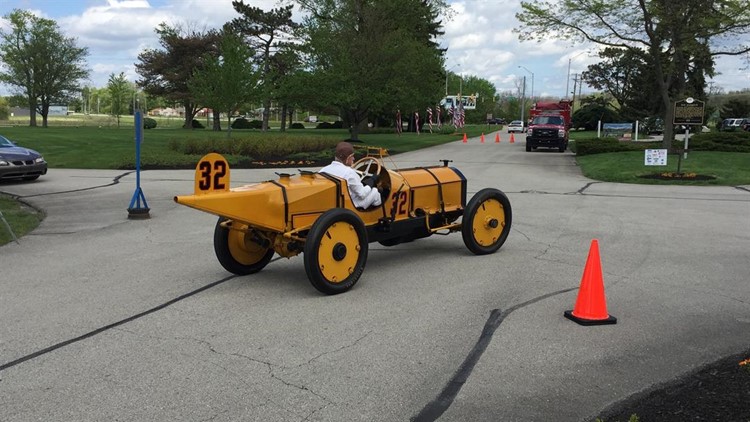The Winchester Barbershop quartet sang Back Home Again in Indiana under a tent at the Anderson Memorial Park Cemetery Sunday. That song was not yet a pre-race tradition when the Marmon Wasp won the first Indianapolis 500 mile race in 1911. The driver of that car was Ray Harroun. His family members joined the city of Anderson and the Indiana Racing Memorial Association for ceremonies to dedicate a memorial marker at the cemetery where Harroun is buried.
Barbara Sherlin, Harroun’s granddaughter and closest living relative, pulled off the black cover to unveil the memorial marker on a beautiful afternoon in Anderson. A wreath was also laid at Harroun’s gravesite.
“It's my Grandpee,” said Sherlin. “To me, he was my grandfather. When I was young, I knew what he had done, but they didn't have the media that they do now."
Coker Tire Company in Chattanooga, Tennessee, built a Marmon Wasp running replica for a movie that never made it to the big screen. Company owner Corky Coker wore a vintage racing uniform with “Harroun” printed on the chest and took the yellow number 32 race car on a short Sunday drive as part of the ceremonies.
“They were real men back then,” Coker said. “He was not a big man. Ray Harroun was not a big man, but he was big in guts. It's a lot of fun because I enjoy racing history and this particular car is one of the most famous race cars in all times."
Harroun considered himself more of an engineer than race car driver. His Marmon Wasp is believed to be the first automobile with a rear view mirror.
“Ray was apparently quoted as saying, ‘The rear view mirror was rather useless because it was vibrating so much I couldn't see a damn thing’,” Indianapolis Motor Speedway announcer Bob Jenkins told the crowd.
Coker told the story that Harroun asked Firestone officials what the optimal speed would be to preserve his tires. They told him 75 miles an hour. The Marmon Wasp suffered just one tire failure.
“Ray Harroun was the ultimate tortoise and the hare story, because he averaged 74.602 miles per hour over the whole 500 miles and in fact won the race,” said Coker. “That wasn't the fastest lap time, but he in fact won the race.”
Harroun was known as the “Little Professor”. In a racing era of riding mechanics, Harroun believed he could go faster and safer alone in a single seat race car.
“His main thing was he did not want to be responsible for a mechanic,” said Sherlin. “They fell out of the car. They got killed. There was one killed at the race. He did not want to be responsible for that. He was a far future thinking man."
“I would describe him as professor-ish,” said Indianapolis Motor Speedway Historian Donald Davidson. He spoke slowly, chose his words, but he just sounded like a scientist."
Harroun retired as a driver after winning the inaugural Indianapolis 500. He finished his life in Anderson, where his race ended in 1968.
The Indiana Racing Memorial Association is placing 19 memorial markers across the state to recognized historical people, places and events as part of the state’s bicentennial celebration.



